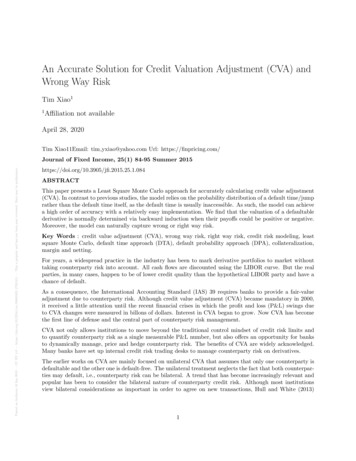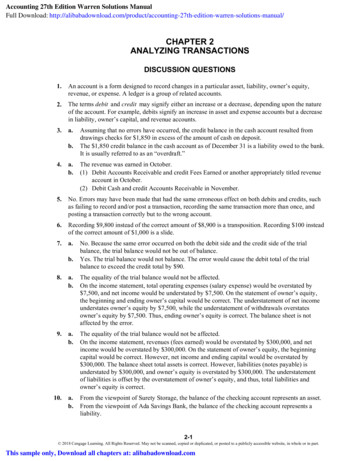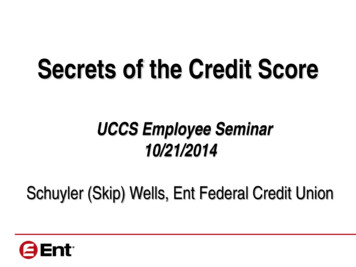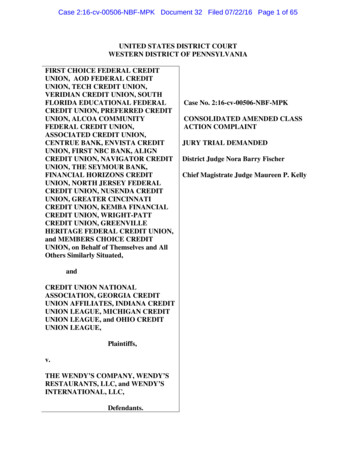
Transcription
An Accurate Solution for Credit Valuation Adjustment (CVA) andWrong Way RiskTim Xiao11Affiliation not availableApril 28, 2020Tim Xiao11Email: tim yxiao@yahoo.com Url: https://finpricing.com/Posted on Authorea 18 Sep 2019 — CC BY 4.0 — https://doi.org/10.22541/au.156881621.17931411 — This a preprint and has not been peer reviewed. Data may be preliminary.Journal of Fixed Income, 25(1) 84-95 Summer ACTThis paper presents a Least Square Monte Carlo approach for accurately calculating credit value adjustment(CVA). In contrast to previous studies, the model relies on the probability distribution of a default time/jumprather than the default time itself, as the default time is usually inaccessible. As such, the model can achievea high order of accuracy with a relatively easy implementation. We find that the valuation of a defaultablederivative is normally determined via backward induction when their payoffs could be positive or negative.Moreover, the model can naturally capture wrong or right way risk.Key Words : credit value adjustment (CVA), wrong way risk, right way risk, credit risk modeling, leastsquare Monte Carlo, default time approach (DTA), default probability approach (DPA), collateralization,margin and netting.For years, a widespread practice in the industry has been to mark derivative portfolios to market withouttaking counterparty risk into account. All cash flows are discounted using the LIBOR curve. But the realparties, in many cases, happen to be of lower credit quality than the hypothetical LIBOR party and have achance of default.As a consequence, the International Accounting Standard (IAS) 39 requires banks to provide a fair-valueadjustment due to counterparty risk. Although credit value adjustment (CVA) became mandatory in 2000,it received a little attention until the recent financial crises in which the profit and loss (P&L) swings dueto CVA changes were measured in billons of dollars. Interest in CVA began to grow. Now CVA has becomethe first line of defense and the central part of counterparty risk management.CVA not only allows institutions to move beyond the traditional control mindset of credit risk limits andto quantify counterparty risk as a single measurable P&L number, but also offers an opportunity for banksto dynamically manage, price and hedge counterparty risk. The benefits of CVA are widely acknowledged.Many banks have set up internal credit risk trading desks to manage counterparty risk on derivatives.The earlier works on CVA are mainly focused on unilateral CVA that assumes that only one counterparty isdefaultable and the other one is default-free. The unilateral treatment neglects the fact that both counterparties may default, i.e., counterparty risk can be bilateral. A trend that has become increasingly relevant andpopular has been to consider the bilateral nature of counterparty credit risk. Although most institutionsview bilateral considerations as important in order to agree on new transactions, Hull and White (2013)1
argue that bilateral CVA is more controversial than unilateral CVA as the possibility that a dealer mightdefault is in theory a benefit to the dealer.CVA, by definition, is the difference between the risk-free portfolio value and the true (or risky or defaultable)portfolio value that takes into account the possibility of a counterparty’s default. The risk-free portfolio valueis what brokers quote or what trading systems or models normally report. The risky portfolio value, however,is a relatively less explored and less transparent area, which is the main challenge and core theme for CVA.In other words, central to CVA is risky valuation.In general, risky valuation can be classified into two categories: thedefault time approach (DTA) and thedefault probability approach (DPA). The DTA involves the default time explicitly. Most CVA models in theliterature (Brigo and Capponi (2008), Lipton and Sepp (2009), Pykhtin and Zhu (2006) and Gregory (2009),etc.) are based on this approach.Posted on Authorea 18 Sep 2019 — CC BY 4.0 — https://doi.org/10.22541/au.156881621.17931411 — This a preprint and has not been peer reviewed. Data may be preliminary.Although the DTA is very intuitive, it has the disadvantage that it explicitly involves the default time. Weare very unlikely to have complete information about a firm’s default point, which is often inaccessible (seeDuffie and Huang (1996), Jarrow and Protter (2004), etc.). Usually, valuation under the DTA is performedvia Monte Carlo simulation. On the other hand, however, the DPA relies on the probability distribution ofthe default time rather than the default time itself. Sometimes the DPA yields simple closed form solutions.The current popular CVA methodology (Pykhtin and Zhu (2006) and Gregory (2009), etc.) is first derivedusing DTA and then discretized over a time grid in order to yield a feasible solution. The discretization,however, is inaccurate. In fact, this model has never been rigorously proved. Since CVA is used for financialaccounting and pricing, its accuracy is essential. Moreover, this current model is based on a well-knownassumption, in which credit exposure and counterparty’s credit quality are independent. Obviously, it cannot capture wrong/right way risk properly.In this paper, we present a framework for risky valuation and CVA. In contrast to previous studies, themodel relies on the DPA rather than the DTA. Our study shows that the pricing process of a defaultablecontract normally has a backward recursive nature if its payoff could be positive or negative.An intuitive way of understanding these backward recursive behaviours is that we can think of that anycontingent claim embeds two default options. In other words, when entering an OTC derivatives transaction,one party grants the other party an option to default and, at the same time, also receives an option to defaultitself. In theory, default may occur at any time. Therefore, the default options are American style optionsthat normally require a backward induction valuation.Wrong way risk occurs when exposure to a counterparty is adversely correlated with the credit quality ofthat counterparty, while right way risk occurs when exposure to a counterparty is positively correlated withthe credit quality of that counterparty. For example, in wrong way risk exposure tends to increase whencounterparty credit quality worsens, while in right way risk exposure tends to decrease when counterpartycredit quality declines. Wrong/right way risk, as an additional source of risk, is rightly of concern to banksand regulators. Since this new model allows us to incorporate correlated and potentially simultaneousdefaults into risky valuation, it can naturally capture wrong/right way risk.The rest of this paper is organized as follows: Section 2 discusses unilateral risky valuation and unilateralCVA. Section 2 elaborates bilateral risky valuation and bilateral CVA. Section 3 presents numerical results.The conclusions are given in Section 4. . All proofs and a practical framework that embraces nettingagreements, margining agreements and wrong/right way risk are contained in the appendices.1. Unilateral Risky Valuation and Unilateral CVAWe consider a filtered probability space (,, , ) satisfying the usual conditions, where denotes a sample space;denotes a -algebra; denotes a probability measure; denotes a filtration.The default model is based on the reduced-form approach proposed by Duffie and Singleton (1999) andJarrow and Turnbell (1994), which does not explain the event of default endogenously, but characterizes it2
exogenously by a jump process. The stopping (or default) time of a firm is modeled as a Cox arrival process(also known as a doubly stochastic Poisson process) whose first jump occurs at default and is defined as,(1)where or denotes the stochastic hazard rate or arrival intensity dependent on an exogenous common state ,and is a unit exponential random variable independent of .It is well-known that the survival probability from time t tos in this framework is defined by(2a)The default probability for the period (t, s ) in this framework is defined by(2b)Two counterparties are denoted as A and B . Let valuation date be t . Consider a financial contract thatpromises to pay a from party B to party A at maturity date T , and nothing before date T . All calculationsin the paper are from the perspective of party A. The risk free value of the financial contract is given byPosted on Authorea 18 Sep 2019 — CC BY 4.0 — https://doi.org/10.22541/au.156881621.17931411 — This a preprint and has not been peer reviewed. Data may be preliminary.(3a)where(3b)where denotes the expectation conditional on the , denotes the risk-free discount factor at time t for thematurity T and denotes the risk-free short rate at time u ().Next, we turn to risky valuation. In a unilateral credit risk case, we assume that party A is default-freeand party B is defaultable. Risky valuation can be generally classified into two categories: the default timeapproach (DTA) and the default probability (intensity) approach (DPA).The DTA involves the default time explicitly. If there has been no default before time T (i.e., ), the value ofthe contract atT is the payoff . If a default happens before T (i.e., ), a recovery payoff is made at the defaulttime as a fraction of the market value11Here we use the recovery of market value (RMV) assumption. givenby where is the default recovery rate and is the market value at default. Under a risk-neutral measure, thevalue of this defaultable contract is the discounted expectation of all the payoffs and is given by(4)where is an indicator function that is equal to one if Y is true and zero otherwise.Although the DTA is very intuitive, it has the disadvantage that it explicitly involves the default time/jump.We are very unlikely to have complete information about a firm’s default point, which is often inaccessible.Usually, valuation under the DTA is performed via Monte Carlo simulation.The DPA relies on the probability distribution of the default time rather than the default time itself. Wedivide the time period (t, T ) into n very small time intervals () and assume that a default may occur onlyat the end of each very small period. In our derivation, we use the approximation for very small y . Thesurvival and the default probabilities for the period (, ) are given by(5a)(5b)The binomial default rule considers only two possible states: default or survival. For the one-period economy,at time the asset either defaults with the default probability or survives with the survival probability . Thesurvival payoff is equal to the market value and the default payoff is a fraction of the market value: . Undera risk-neutral measure, the value of the asset at t is the expectation of all the payoffs discounted at therisk-free rate and is given by3
(6)where denotes the risky rate and is called the (short) credit spread.Similarly, we have(7)Note that is -measurable. By definition, an -measurable random variable is a random variable whose valueis known at time . Based on thetaking out what is known and tower properties of conditional expectation,we have(8)By recursively deriving from t forward over T and taking the limit as approaches zero, the risky value ofthe asset can be expressed asPosted on Authorea 18 Sep 2019 — CC BY 4.0 — https://doi.org/10.22541/au.156881621.17931411 — This a preprint and has not been peer reviewed. Data may be preliminary.(9)We may think of as the risk-adjusted short rate. Equation (9) is the same as Equation (10) in Duffie andSingleton [1999], which is the market model for pricing risky bonds. Using the DPA, we obtain a closed-formsolution for pricing an asset subject to credit risk. Other good examples of the DPA are the CDS modelproposed by J.P. Morgan (1999) and a more generic risky model presented by Xiao (2013a).In theory, a default may happen at any time, i.e., a risky contract is continuously defaultable. This Continuous Time Risky Valuation Model is accurate but sometimes complex and expensive. For simplicity, peoplesometimes prefer the Discrete Time Risky Valuation Model that assumes that a default may only happen atsome discrete times. A natural selection is to assume that a default may occur only on the payment dates.Fortunately, the level of accuracy for this discrete approximation is well inside the typical bid-ask spreadfor most applications (see O’Kane and Turnbull (2003)). From now on, we will focus on the discrete settingonly, but many of the points we make are equally applicable to the continuous setting.4
Posted on Authorea 18 Sep 2019 — CC BY 4.0 — https://doi.org/10.22541/au.156881621.17931411 — This a preprint and has not been peer reviewed. Data may be preliminary.Figure 1: Couldn’t find a caption, edit here to supply one.For a derivative contract, usually its payoff may be either an asset or a liability to each party. Thus, wefurther relax the assumption and suppose thatmay be positive or negative.5
Posted on Authorea 18 Sep 2019 — CC BY 4.0 — https://doi.org/10.22541/au.156881621.17931411 — This a preprint and has not been peer reviewed. Data may be preliminary.Figure 2: Couldn’t find a caption, edit here to supply one.In the case of , the survival value is equal to the payoff and the default payoff is a fraction of the payoff .Whereas in the case of , the contract value is the payoff itself, because the default risk of party B is irrelevantfor unilateral risky valuation in this case. Therefore, we haveProposition 1: The unilateral risky value of the single-payment contract in a discrete-time setting is givenby(10a)where(10b)Proof: See the appendix.Here can be regarded as a risk-adjusted discount factor. Proposition 1 says that the unilateral risky valuationof the single payoff contract has a dependence on the sign of the payoff. If the payoff is positive, the riskyvalue is equal to the risk-free value minus the discounted potential loss. Otherwise, the risky value is equalto the risk-free value.Proposition 1 can be easily extended from one-period to multiple-periods. Suppose that a defaultable contracthas m cash flows. Let the m cash flows be represented as ,. . . , with payment dates ,. . . ,. Each cash flowmay be positive or negative. We have the following proposition.6
Proposition 2: The unilateral risky value of the multiple-payment contract is given by(11a)where and(11b)Proof: See the appendix.Posted on Authorea 18 Sep 2019 — CC BY 4.0 — https://doi.org/10.22541/au.156881621.17931411 — This a preprint and has not been peer reviewed. Data may be preliminary.The risky valuation in Proposition 2 has a backward nature. The intermediate values are vital to determinethe final price. For a discrete time interval, the current risky value has a dependence on the future riskyvalue. Only on the final payment date , the value of the contract and the maximum amount of informationneeded to determine the risk-adjusted discount factor are revealed. The coupled valuation behavior allowsus to capture wrong/right way risk properly where counterparty credit quality and market prices may becorrelated. This type of problem can be best solved by working backwards in time, with the later risky valuefeeding into the earlier ones, so that the process builds on itself in a recursive fashion, which is referred toasbackward induction . The most popular backward induction valuation algorithms are lattice/tree and leastsquare Monte Carlo.For an intuitive explanation, we can posit that a defaultable contract under the unilateral credit risk assumption has an embedded default option (see Sorensen and Bollier (1994)). In other words, one party enteringa defaultable financial transaction actually grants the other party an option to default. If we assume that adefault may occur at any time, the default option is an American style option. American options normallyhave backward recursive natures and require backward induction valuations.The similarity between American style financial options and American style default options is that bothrequire a backward recursive valuation procedure. The difference between them is in the optimal strategy.The American financial option seeks an optimal value by comparing the exercise value with the continuationvalue, whereas the American default option seeks an optimal discount factor based on the option value intime.The unilateral CVA, by definition, can be expressed as(12)Proposition 2 provides a general form for pricing a unilateral defaultable contract. Applying it to a particularsituation in which we assume that all the payoffs are nonnegative, we derive the following corollary:Corollary 1: If all the payoffs are nonnegative, the risky value of the multiple-payments contract is givenby(13a)where and(13b)The proof of this corollary is easily obtained according to Proposition 2 by setting , since the value of thecontract at any time is also nonnegative.The CVA in this case is given by(14)The current popular CVA model (e.g., equation (17) in Pykhtin and Zhu (2007) and equation (3) in Gregory(2009)) is quite different from above either equation (12) or equation (14). As a matter of fact, the currentCVA model has never been rigorously proved. In order to reflect the economic value of counterparty creditrisk, to measure the profit and loss of a bank and to provide proper incentives to traders, a good CVA modelmust be not only rigorous and accurate but also feasible to implement.7
1. Bilateral Risky Valuation and Bilateral CVAThere is ample evidence that corporate defaults are correlated. The default of a firm’s counterparty mightaffect its own default probability. Thus, default correlation and dependence arise due to the counterpartyrelations. Default correlation can be positive or negative. The effect of positive correlation is usually calledcontagion, whereas the latter is referred to as competition effect.Two counterparties are denoted as A and B . The binomial default rule considers only two possible states:default or survival. Therefore, the default indicator for party j (j A, B ) follows a Bernoulli distribution,which takes value 1 with default probability and value 0 with survival probability , i.e., and . The marginaldefault distributions can be determined by the reduced-form models. The joint distributions of a bivariateBernoulli variable can be easily obtained via the marginal distributions by introducing extra correlations.Consider a pair of random variables (,) that has a bivariate Bernoulli distribution. The joint probabilityrepresentations are given by(15a)(15b)Posted on Authorea 18 Sep 2019 — CC BY 4.0 — https://doi.org/10.22541/au.156881621.17931411 — This a preprint and has not been peer reviewed. Data may be preliminary.(15c)(15d)where ,, where denotes the default correlation coefficient and denotes the default covariance.Table 1. Payoffs of a bilaterally defaultable contractThis table displays all possible payoffs at time T . In the case of , there are a total of four possible statesat time T: i) BothA and B survive with probability . The contract value is equal to the payoff . ii) Adefaults but B survives with probability. The contract value is , where represents the non-default recoveryrate11There are two default settlement rules in the market. The one-way payment rule was specified bythe early ISDA master agreement. The non-defaulting party is not obligated to compensate the defaultingparty if the remaining market value of the instrument is positive for the defaulting party. The two-waypayment rule is based on current ISDA documentation. The non-defaulting party will pay the full marketvalue of the instrument to the defaulting party if the contract has positive value to the defaulting party. 0 represents the one-way settlement rule, while 1 represents the two-way settlement rule. iii) A survivesbutB defaults with probability . The contract value is , where represents the default recovery rate. iv) BothA and B default with probability . The contract value is , where denotes the joint recovery rate when bothparties A and B default simultaneously. A similar logic applies to the case of ilityA & B surviveA defaults, B survivesA survives, B defaultsA & B defaultSuppose that a financial contract that promises to pay a from partyB to party A at maturity date T , andnothing before date T where . The payoff may be positive or negative, i.e. the contract may be either anasset or a liability to each party. All calculations are from the perspective of party A.At time T , there are a total of four () possible states shown in Table 1. The risky value of the contract isthe discounted expectation of the payoffs and is given by the following proposition.Proposition 3: The bilateral risky value of the single-payment contract is given by(16a)8
where(16b)(16c)Proof: See the appendix.We may think of as the risk-adjusted discount factor. Proposition 3 tells us that the bilateral risky price ofa single-payment contract can be expressed as the present value of the payoff discounted by a risk-adjusteddiscount factor that has a switching-type dependence on the sign of the payoff.Using a similar derivation as in Proposition 2, we can easily extend Proposition 3 from one-period to multipleperiods. Suppose that a defaultable contract has m cash flows. Let the m cash flows be represented as withpayment dates , where i 1,. . . ,m . Each cash flow may be positive or negative. The bilateral risky valueof the multiple-payment contract is given byProposition 4: The bilateral risky value of the multiple-payment contract is given by(17a)Posted on Authorea 18 Sep 2019 — CC BY 4.0 — https://doi.org/10.22541/au.156881621.17931411 — This a preprint and has not been peer reviewed. Data may be preliminary.where and(17b)where and are defined in Proposition 3.Proof: The proof is similar to Proposition 2 by replacing with .Proposition 4 says that the pricing process of a multiple-payment contract has a backward nature since thereis no way of knowing which risk-adjusted discounting rate should be used without knowledge of the futurevalue. Only on the maturity date, the value of the contract and the decision strategy are clear. Therefore,the evaluation must be done in a backward fashion, working from the final payment date towards the present.This type of valuation process is referred to as backward induction.There is a common misconception in the market. Many people believe that the cash flows of a defaultablefinancial contract can be priced independently and then be summed up to give the final risky price of thecontract. We emphasize here that this conclusion is only true of the financial contracts whose payoffs arealways positive. In the cases where the promised payoffs could be positive or negative, the valuation requiresnot only a backward recursive induction procedure, but also a strategic selection of different discount factorsaccording to the market value in time. This coupled valuation process allows us to capture correlationbetween counterparties and market factors.The bilateral CVA of the multiple-payment contract can be expressed as(18)1. Numerical ResultsIn this section, we present some numerical results for CVA calculation based on the theory described above.First, we study the impact of margin agreements on CVA. The testing portfolio consists of a number ofinterest rate and equity derivatives. The number of simulation scenarios (or paths) is 20,000. The timebuckets are set weekly. If the computational requirements exceed the system limit, one can reduce both thenumber of scenarios and the number of time buckets. The time buckets can be designed fine-granularity atthe short end (e.g., daily and then weekly) and coarse-granularity at the far end (e.g. monthly and thenyearly). The rationale is that the calculation becomes less accurate due to the accumulated error fromsimulation discretization, and inherited errors from calibration of the underlying models, such as those dueto the change of macro-economic climate. The collateral margin period of risk is assumed to be 14 days (2weeks).9
For risk-neutral simulation, we use a Hull-White model for interest rate and a CIR (Cox-Ingersoll-Ross)model for hazard rate scenario generations a modified GBM (Geometric Brownian Motion) model for equityand collateral evolution. The results are presented in the following tables. Table 2 illustrates that if partyA has an infinite collateral threshold i.e., no collateral requirement on A , the CVA value increases whilethe threshold increases. Table 3 shows that if party B has an infinite collateral threshold , the CVA valueactually decreases while the threshold increases. This reflects the bilateral impact of the collaterals on theCVA. The impact is mixed in Table 4 when both parties have finite collateral thresholds.Table 2. The impact of collateral threshold on the CVAThis table shows that given an infinite , the CVA increases while increases, where denotes the collateralthreshold of party B and denotes the collateral threshold of party A .Collateral ThresholdCollateral ThresholdCVA10.1 Mil10.1 Mil25,752.9815.1 Mil15.1 Mil22,448.4520.1 Mil20.1 Mil23,288.24Infinite ()Infinite ()22,059.30Posted on Authorea 18 Sep 2019 — CC BY 4.0 — https://doi.org/10.22541/au.156881621.17931411 — This a preprint and has not been peer reviewed. Data may be preliminary.Table 3. The impact of collateral threshold on the CVAThis table shows that given an infinite , the CVA decreases while increases, where denotes the collateralthreshold of party B and denotes the collateral threshold of party A .Collateral ThresholdCollateral ThresholdCVA10.1 Mil10.1 Mil25,752.9815.1 Mil15.1 Mil22,448.4520.1 Mil20.1 Mil23,288.24Infinite ()Infinite ()22,059.30Table 4. The impact of the both collateral thresholds on the CVAThe CVA may increase or decrease while both collateral thresholds change, where denotes the collateralthreshold of party B and denotes the collateral threshold of party A . This reflects the fact that the collateralshave bilateral impacts on the CVA.Collateral ThresholdCollateral ThresholdCVA10.1 Mil10.1 Mil25,752.9815.1 Mil15.1 Mil22,448.4520.1 Mil20.1 Mil23,288.24Infinite ()Infinite ()22,059.30Next, we examine the impact of wrong way risk. Wrong way risk occurs when exposure to a counterparty isadversely correlated with the credit quality of that counterparty, while right way risk occurs when exposureto a counterparty is positively correlated with the credit quality of that counterparty. Wrong/right way risk,as an additional source of risk, is rightly of concern to banks and regulators.Some financial markets are closely interlinked, while others are not. For example, CDS price movementshave a feedback effect on the equity market, as a trading strategy commonly employed by banks and othermarket participants consists of selling a CDS on a reference entity and hedging the resulting credit exposureby shorting the stock. On the other hand, Moody’s Investor’s Service (2000) presents statistics that suggestthat the correlations between interest rates and CDS spreads are very small.To capture wrong/right way risk, we need to determine the dependency between counterparties and tocorrelate the credit spreads or hazard rates with the other market risk factors, e.g. equities, commodities,etc., in the scenario generation.We use an equity swap as an example. Assume the correlation between the underlying equity price and the10
credit quality (hazard rate) of partyB is. The impact of the correlation on the CVA is show in Table 5. Theresults say that the CVA increases when the absolute value of the negative correlation increases.Table 5. The impact of wrong way risk on the CVAThis table shows that the CVA increases while the negative correlation increases in the absolute value. Weuse an equity swap as an example and assume that there is a negative correlation between the equity priceand the credit quality of party B .CorrelationCVA0165.15-50%205.95-100%236.99Posted on Authorea 18 Sep 2019 — CC BY 4.0 — https://doi.org/10.22541/au.156881621.17931411 — This a preprint and has not been peer reviewed. Data may be preliminary.1. ConclusionThis article presents a framework for pricing risky contracts and their CVAs. The model relies on theprobability distribution of the default jump rather than the default jump itself, because the default jumpis normally inaccessible. We find that the valuation of risky assets and their CVAs, in most situations,has a backward recursive nature and requires a backward induction valuation. An intuitive explanation isthat two counterparties implicitly sell each other an option to default when entering into an OTC derivativetransaction. If we assume that a default may occur at any time, the default options are American styleoptions. If we assume that a default may only happen on the payment dates, the default options areBermudan style options. Both Bermudan and American options require backward induction valuations.Based on our theory, we propose a novel cash-flow-based framework (see appendix) for calculating bilateralCVA at the counterparty portfolio level. This framework can easily incorporate various credit mitigationtechniques, such as netting agreements and margin agreements, and can capture wrong/right way risk.Numerical results show that these credit mitigation techniques and wrong/right way risk have significantimpacts on CVA.Appendix1. ProofsProof of Proposition 1: Under the unilateral credit risk assumption, we only consider the default riskwhen the asset is in the money. Assume that a default may only occur on the payment date. Therefore, therisky value of the asset at t is the discounted expectation of all possible payoffs and is given by(A1a)where(A1b)Proof of Proposition 2: Let . On the first payment day, let denote the
adjustment due to counterparty risk. Although credit value adjustment (CVA) became mandatory in 2000, it received a little attention until the recent nancial crises in which the pro t and loss (P&L) swings due to CVA changes were measured in billons of dollars. Interest in CVA began to grow. Now CVA has become the rst line of defense and the .











